英语语音练习题
英语语音练习题及答案
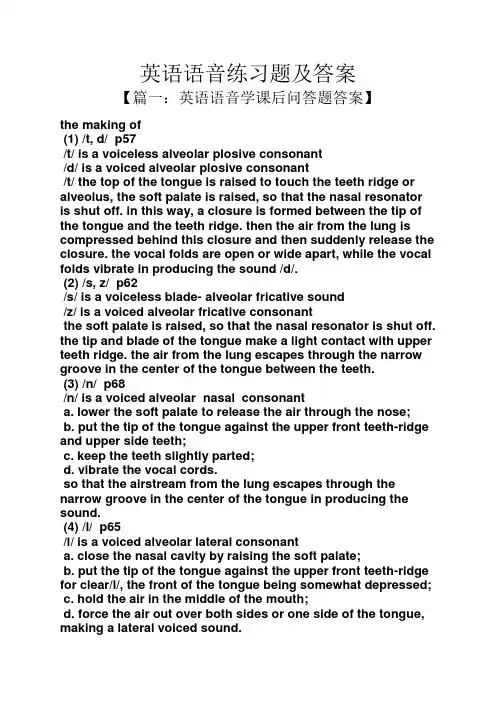
英语语音练习题及答案【篇一:英语语音学课后问答题答案】the making of(1) /t, d/ p57/t/ is a voiceless alveolar plosive consonant/d/ is a voiced alveolar plosive consonant/t/ the top of the tongue is raised to touch the teeth ridge or alveolus, the soft palate is raised, so that the nasal resonator is shut off. in this way, a closure is formed between the tip of the tongue and the teeth ridge. then the air from the lung is compressed behind this closure and then suddenly release the closure. the vocal folds are open or wide apart, while the vocal folds vibrate in producing the sound /d/.(2) /s, z/ p62/s/ is a voiceless blade- alveolar fricative sound/z/ is a voiced alveolar fricative consonantthe soft palate is raised, so that the nasal resonator is shut off. the tip and blade of the tongue make a light contact with upper teeth ridge. the air from the lung escapes through the narrow groove in the center of the tongue between the teeth.(3) /n/ p68/n/ is a voiced alveolar nasal consonanta. lower the soft palate to release the air through the nose;b. put the tip of the tongue against the upper front teeth-ridge and upper side teeth;c. keep the teeth slightly parted;d. vibrate the vocal cords.so that the airstream from the lung escapes through the narrow groove in the center of the tongue in producing the sound.(4) /l/ p65/l/ is a voiced alveolar lateral consonanta. close the nasal cavity by raising the soft palate;b. put the tip of the tongue against the upper front teeth-ridge for clear/l/, the front of the tongue being somewhat depressed;c. hold the air in the middle of the mouth;d. force the air out over both sides or one side of the tongue, making a lateral voiced sound.2. classify the vowels in different ways. p16-17the pure vowels can be classified according to different 4 principles.(2) according to the length of the vowels, they are divided into long vowels and short vowels. the pure vowels in transcription with two dots are long vowels. the diphthongs are also long. the rest are short ones.(3) according to the shape of the lips, the vowels can be divided into rounded vowels and uounded (spread) vowels. the rounded vowels are /?:/ /u:/ /?/ /?/ and the rest are uounded vowels.(4) according to the degree of tenseness of the muscles, the pure vowels are classified asthe eight diphthongs can be classified as closing diphthongs /e?/ /a?/ /??/ /??/ /a?/.and centring diphthongs /??/ /e?/ /??/.3. classify the consonants in different ways. p17-18there are 24 consonants in english. they are classified according to three different principles:1) the vibration of the vocal folds: those with the vibration of the vocal cords are called voiced consonants. those without the vibration of the vocal cords are called voiceless or breathed consonants.2) place of articulation: i.e., where the obstruction of the air passage is formed, the consonants can be distinguished as bilabial, labiodental, dental, alveolar, post-alveolar, palato-alveolar, palatal, velar, and glottal consonants.3) manner of articulation: they can be distinguished as plosives, fricatives, affricates, nasals, laterals, frictionless continuant and semi-vowels.4. how are /i:/ and /i/ produced? what’s the difference between them? p21-22/i:/: the front of the tongue is raised to a height slightly below and behind the front close position; the lips are spread; the tongue is tense; the side rims make a firm contact with the upper molars; it is generally long./i/: the rp vowel /i/ is pronounced with a part of the tongue nearer to the center than to front. it is raised just above the close-mid position; the lips are loosely spread; the tongue is lax; the side rims make a light contact with the upper molars; it is generally short.the difference is not merely the length of sound. there is also a difference in tongue position or quality. for /i:/ the part of the tongue that is highest is the centre of the “front” while for /i/ it is the hinder part of the “front”.5. what are the common features of the front vowels? p26(1) the front of the tongue is raised to various levels in the direction of the hard palate.(2) the tip of the tongue is usually kept down behind the lower teeth.(3) the lips are spread.6. how are the plosives produced? p56plosives are sounds resulting from a blocking or stopping effect on the airstream.6 plosives: /p/,/b/,/t/,/d/,/k/,/g//p/: a voiceless, bilabial plosive consonanta. raise the soft palate so that the nasal cavity is closed;b. breathe in the air and close the lips;c. hold the air behind the closure;d. part the lips open suddenly so that the air comes out of the mouth with a plosive sound;e. do not vibrate the vocal cords. /b/: a voiced bilabial consonantthe organic formation for /b/ is exactly the same as that for /p/ except that the air comes outof the mouth less forcefully and that the vocal cords vibrate./t/: a voiceless alveolar plosive consonanta. raise the soft palate so that the nasal cavity is closed;b. put the tip and blade of the tongue against the upper teeth ridge so that a closure isformed;c. hold the air behind the closure;d. release the closure and blade suddenly so that the air escapes with a plosive sound;e. do not vibrate the vocal folds. /d/: a voiced alveolar plosive consonantthe organic formation for /d/ is the same as that for /t/ except that the air is released less strongly and that the vocal folds vibrate./k/: a voiceless velar plosive consonant.a. raise the soft palate so that the nasal cavity is closed;b. lift the back of the tongue to touch the soft palate so that a closure is formed;c. stop the air stream behind the closure;d. break the closure and the plosive sound is heard;e. be careful not to vibrate the vocal folds./g/: a voiceless velar plosive consonantthe organic formation for /g/ is the same as that for /k/ except that the vocal cords vibrate when the air is released.7. how do you make the affricates /t?/and /d?/? p70/t?/: a voiceless palate-alveolar affricate consonanta. raise the soft palate to stop the air passage and put up the tip of the tongue to touch theback part of the teeth-ridge to form a retracted /t?/ closure;b. the main part of tongue is in position for /?/;c. release the closure slowly, and the air escapes all over the central part of the tongue withfriction;d. the lips are usually somewhat protruded;e. the vocal cords are not made to vibrate./d?/: a voiced palate-alveolar affricate consonantthe affricate /d?/ is formed like /t?/ except that the breath force is weaker and the vocal cords are made to vibrate.8. why are /w/ and /j/ called semi-vowels? p73the semi-vowels have both the features of vowels and consonants.9. please explain “open syllables” and “closed syllables”.p77open syllables are those without any consonant at the end. in british rp only a restricted set of vowels can occur.closed syllables are those that have one or more consonants at the end. all the vowels can appear in these circumstances.10. what is called incomplete plosion? p84when the release stage of a plosive sound is missing or delayed, it is known as incomplete plosion. it takes place in a word when a plosive is followed immediately by another plosive, or a fricative, or an affricate. it may also take place at the junction of words (unless they are separated by a pause).11. when do we have liaison? p86a. consonant (except r) + vowelthe final consonant of the preceding world is united tothe initial vowel of the next word in the same sense group.e.g. give it uphalf an hourb. –r or –re + vowelwhen a word ending with the letter”-r” or “-re” is followed by a wordbeginning with a vowel, the sound /r/ is usually inserted in the pronunciation.e.g. after all far and widec. vowel + vowelwhen a word ending in a vowel is followed by another word beginningwith a vowel, a short/j/ glide is inserted after /i:/, /i/, /ei/, /ai/ and /?i/, or a /w/ glide after /u:/,/u/,/?u/, and/au/e.g. at the endhurry up12. how do you explain assimilation? p95speech sounds seldom occur in isolation. in connected speech, under the influence of their neighbors, are replaced by other sounds. sometimes two neighboring sounds influence each other and are replaced by a new sound which is different from either of the two original sounds. this process is called assimilation.13. how many kinds of stress are there in a word? what are they? p107three principal kinds.(1) primary stress--heavily stressed, usually marked with a vertical stroke() on the upper left hand corner of a syllable carrying the stress, as in be’gin.(2) secondary stress--stressed but subordinate to the primary stress, usually marked with a vertical stroke (?) on the lower left hand corner of a syllable concerned, as in ?contribution.le stress or even stress. double stress can be marked by a high vertical stroke before each of the stressed syllable, as in /?f?f’ti:n/, /b ?:’l?n/, etc.14. how is sentence stress classified? for example. p115-119 three types: sense stress, logical stress, emotional stress.15. please define sense-groups. p140sense-groups are groups of words which are closely connected in meaning and grammar. each sense-group comprises a number of syllables. generally speaking, about six or seven syllables are considered appropriate.16. how many kinetic tones do you know? p153-154the tones which glide from one height to another are called kinetic tone. they are high fall, low fall; high rise, low rise; high fall-rise, and low fall-rise; rise-fall and rise-fall-rise.17. what is a tune? what are the features of the englishtune?p159,164the intonation of the whole tone-group is called a tune.a. normally a low prehead.b. normally a high head.c. in the body, the stressed syllables occupy mostly level pitches and they all fall downgradually in pitch. the unstressed syllables between the stresses ones have about the same height as the stressed syllable preceding them.d. the nucleus is usually at the end of the tune when something is uttered in isolation.e. the changes in the tail are determined by the nucleus. in a fall, the tail remains on a lowlevel pitch[ ]; in a rise or fall-rise, the tail rises gradually[ ]. 18. what’s the function of the falling-rising tune? p173it is used to show contrast, reservation, implication, disagreement, contradiction or warning, etc.1) declarative sentence: the falling-rising tune used in declarative sentences indicates incompleteness and implications, such as concession, gratitude, regret, apology, request, reproach and rebut, etc.2) interrogative sentences:a. special questions: the falling-rising tune used in the special question is stronger than the rising tune. it expresses surprise, interest, request, sympathy, disgust and disbelief, etc.b. general questions: the falling-rising tune used in the general question can express hesitation, request, agitation, exaggeration, etc. no answer is expected by the speaker. c. disjunctive question.3) imperative sentence: the falling-rising tune used in the imperative sentence expresses a warning or an urgent request.4) exclamatory sentence: the falling-rising tune is seldom used in exclamatory sentences. however, when used, it expresses enthusiasm, appreciation, sympathy, encouragement, regret and contempt, etc.【篇二:英语音标练习题—判断发音(含答案)[1]_2】>一、选出划线部分与其他三项发音不同的一项 ( c( a ( d ( b ( b ( a( d( b ( a ( c ( d ( c ( a ( b ( c( a ( d ( b ( a ( a ( b( c ( b ( c ( b ( d ( d ( c ( b( a ( b ( c ( c ( a( a ( b ( d ( d- 1 -- 2 -(((((((((((((((((((((((【篇三:英语语音练习题一】国际音标共48个音素,其中元音音素20个,辅音音素28个。
英语语音练习试题
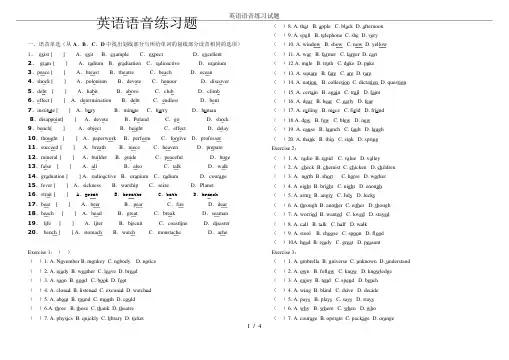
5、debt [ ] A.habit
B.above
C.club
D.climb
( )15. A. certain B. again C. trail D. faint
6、effect [ ] A.determination B.debt C.endless
D.bent
( )16. A. dear B. hear C. early D. fear
( )6.A. three B. those C. thank D. theatre
( )6. A. why B. where C. when D. who
( )7. A. physics B. quickly C. library D. ticket
1/4
( )7. A. courage B. operate C. package D. orange
1、 exist [ ] A.exit B.example C.expect
D.excellent
( )11. A. war B. farmer C. larger D. cart
2、 gram [ ] A.radium B.graduation C.radioactive
D.uranium
( )12.A. mule B. truth C. duke D. puke
7、institute [ ] A.bury
B.minute C.hurry
D.human
( )17. A. ceiling B. niece C. field D. friend
8、disappoint[ ] A.devote
B.Poland
C.go
D.shock
( )18.A. dew B. few C. blew D. new
小学英语语音练习题
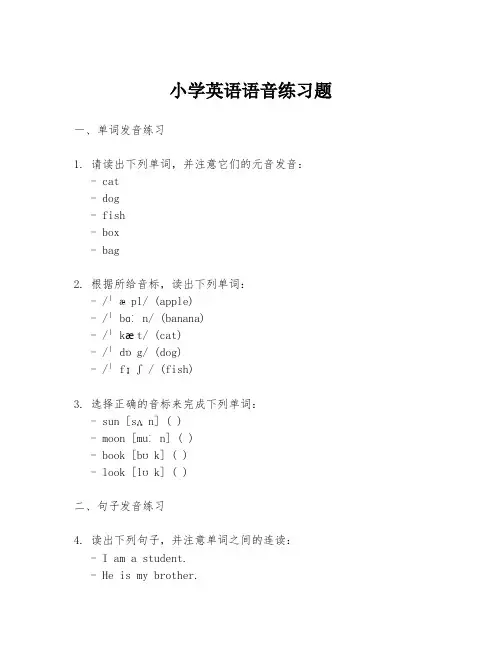
小学英语语音练习题一、单词发音练习1. 请读出下列单词,并注意它们的元音发音:- cat- dog- fish- box- bag2. 根据所给音标,读出下列单词:- /ˈæpl/ (apple)- /ˈbɑːn/ (banana)- /ˈkæt/ (cat)- /ˈdɒg/ (dog)- /ˈfɪʃ/ (fish)3. 选择正确的音标来完成下列单词:- sun [sʌn] ( )- moon [muːn] ( )- book [bʊk] ( )- look [lʊk] ( )二、句子发音练习4. 读出下列句子,并注意单词之间的连读:- I am a student.- He is my brother.- She has a cat.- We like to play football.5. 根据所给音标,读出下列句子:- /ˈhɛlˈloʊ/ Hello, how are you? - /ˈwaʧɪŋ/ I am watching TV.- /ˈdɑːnsɪŋ/ She is dancing.6. 完成下列对话,并注意正确的语音语调: - A: What is your name?B: My name is [ ].- A: Where are you from?B: I am from [ ].三、语音辨析练习7. 听录音,选择发音相同的单词:- A. cat, hat- B. dog, bog- C. fish, wish- D. box, fox8. 听录音,选择正确的句子:- A. I can see a bird.- B. I can see a bed.- C. I can see a bear.9. 听录音,判断下列句子的发音是否正确: - A. The cat is on the mat. ( )- B. The dog is under the rug. ( ) - C. The fish is in the dish. ( )四、语音综合练习10. 根据所给单词,造句并读出:- book- read- like11. 根据所给句子,变换时态并读出:- He is playing basketball. (现在进行时变为一般现在时) - She was reading a book. (过去进行时变为一般过去时)12. 根据所给情景,编写并读出对话:- 情景:在学校图书馆,两个学生在找书。
小学英语语音专项训练题一
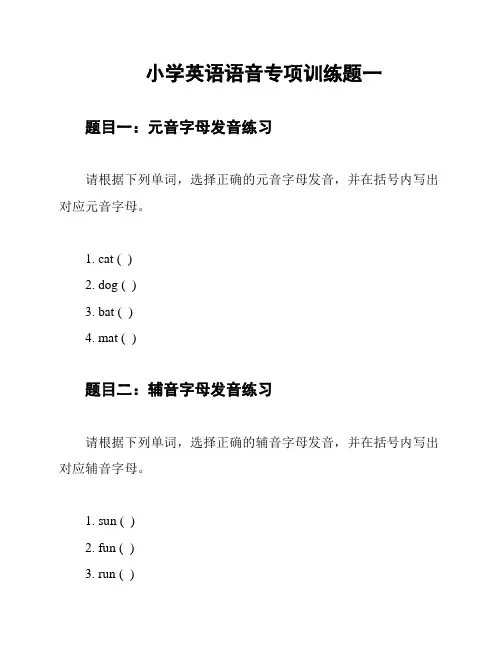
小学英语语音专项训练题一题目一:元音字母发音练习请根据下列单词,选择正确的元音字母发音,并在括号内写出对应元音字母。
1. cat ( )2. dog ( )3. bat ( )4. mat ( )题目二:辅音字母发音练习请根据下列单词,选择正确的辅音字母发音,并在括号内写出对应辅音字母。
1. sun ( )2. fun ( )3. run ( )4. nut ( )题目三:元音字母组合发音练习请根据下列单词,选择正确的元音字母组合发音,并在括号内写出对应元音字母组合。
1. tea ( )2. sea ( )3. eat ( )4. meet ( )题目四:辅音字母组合发音练习请根据下列单词,选择正确的辅音字母组合发音,并在括号内写出对应辅音字母组合。
1. sky ( )2. try ( )3. cry ( )4. fry ( )题目五:语音辨析练习请根据下列单词,选择正确的发音,并在括号内写出对应单词。
1. mouse [maus] ( )2. house [haus] ( )3. ship [ʃip] ( )4. sheep [ʃi:p] ( )5. stop [stɔp] ( )6. stip [stɪp] ( )答案解析以下是每个题目的答案及解析:题目一:元音字母发音练习1. cat (a)2. dog (o)3. bat (a)4. mat (a)解析:这组题目主要考察的是元音字母a的发音。
在cat、bat、mat这三个单词中,元音字母a的发音都是[æ]。
而在dog这个单词中,元音字母o的发音是[ɒ]。
题目二:辅音字母发音练习1. sun (ʌ)2. fun (ʌ)3. run (ʌ)4. nut (ʌ)解析:这组题目主要考察的是辅音字母组合“n”和元音字母“u”的发音。
在这四个单词中,辅音字母组合“n”的发音是[n],而元音字母“u”的发音是[ʌ]。
题目三:元音字母组合发音练习1. tea (iː)2. sea (iː)3. eat (iː)4. meet (iː)解析:这组题目主要考察的是元音字母组合“ee”的发音。
五年级英语语音练习题40题
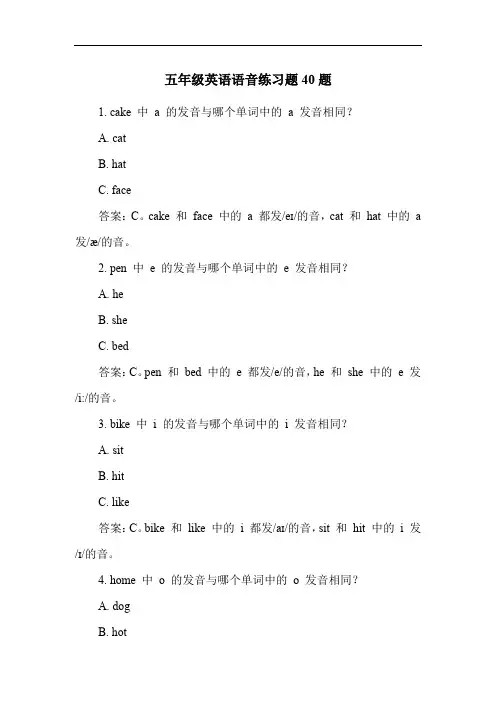
五年级英语语音练习题40题1. cake 中a 的发音与哪个单词中的a 发音相同?A. catB. hatC. face答案:C。
cake 和face 中的a 都发/eɪ/的音,cat 和hat 中的a 发/æ/的音。
2. pen 中e 的发音与哪个单词中的e 发音相同?A. heB. sheC. bed答案:C。
pen 和bed 中的e 都发/e/的音,he 和she 中的e 发/i:/的音。
3. bike 中i 的发音与哪个单词中的i 发音相同?A. sitB. hitC. like答案:C。
bike 和like 中的i 都发/aɪ/的音,sit 和hit 中的i 发/ɪ/的音。
4. home 中o 的发音与哪个单词中的o 发音相同?A. dogB. hot答案:C。
home 和nose 中的o 都发/əʊ/的音,dog 和hot 中的o 发/ɒ/的音。
5. cute 中u 的发音与哪个单词中的u 发音相同?A. busB. cupC. use答案:C。
cute 和use 中的u 都发/ju:/的音,bus 和cup 中的u 发/ʌ/的音。
6. map 中a 的发音与哪个单词中的a 发音相同?A. nameB. gameC. bag答案:C。
map 和bag 中的a 都发/æ/的音,name 和game 中的a 发/eɪ/的音。
7. pig 中i 的发音与哪个单词中的i 发音相同?A. fiveB. nineC. big答案:C。
pig 和big 中的i 都发/ɪ/的音,five 和nine 中的i 发/aɪ/的音。
8. go 中o 的发音与哪个单词中的o 发音相同?B. lotC. no答案:C。
go 和no 中的o 都发/əʊ/的音,not 和lot 中的o 发/ɒ/的音。
9. duck 中u 的发音与哪个单词中的u 发音相同?A. pupilB. tubeC. cut答案:C。
高中英语语音练习题
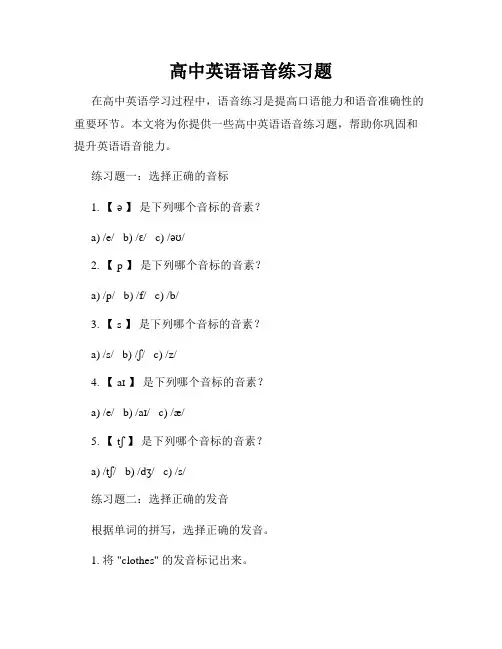
高中英语语音练习题在高中英语学习过程中,语音练习是提高口语能力和语音准确性的重要环节。
本文将为你提供一些高中英语语音练习题,帮助你巩固和提升英语语音能力。
练习题一:选择正确的音标1. 【ə】是下列哪个音标的音素?a) /e/ b) /ɛ/ c) /əʊ/2. 【 p 】是下列哪个音标的音素?a) /p/ b) /f/ c) /b/3. 【 s 】是下列哪个音标的音素?a) /s/ b) /ʃ/ c) /z/4. 【 aɪ】是下列哪个音标的音素?a) /e/ b) /aɪ/ c) /æ/5. 【 tʃ】是下列哪个音标的音素?a) /tʃ/ b) /dʒ/ c) /s/练习题二:选择正确的发音根据单词的拼写,选择正确的发音。
1. 将 "clothes" 的发音标记出来。
a) /kləʊðz/ b) /kləʊz/ c) /kləʊθz/2. 将 "kitchen" 的发音标记出来。
a) /ˈkɪʧən/ b) /ˈkɪtʃən/ c) /ˈkɪsən/3. 将 "photograph" 的发音标记出来。
a) /ˈfəʊtəʊɡrɑːf/ b) /ˈfəʊtəɡræf/ c) /ˈfəʊtəɡræfs/4. 将 "important" 的发音标记出来。
a) /ɪmˈpɔːtənt/ b) /ɪmˈpɔːrtənt/ c) /ɪŋˈpɔːrtənt/5. 将 "height" 的发音标记出来。
a) /haɪt/ b) /heɪt/ c) /hɛɪt/练习题三:音标转写根据下列单词的发音,将其转写为音标。
1. Place ______________________2. Thin _______________________3. Dream ______________________4. Session ____________________5. Beach ______________________练习题四:连读与重音根据对话内容,判断句子中是否存在连读或需要特别注意重读的单词。
英语语音练习题(找出相同的音)及答案
二、语音单选(找出划线部分与所给单词的划线部分读音相同的选项)1、 exist A.exit B.example C.expect D.excellent2、 gram A.radium B.graduation C.radioactive D.uranium3、peace A.breast B.theatre C.beach D.ocean4、shock A.polonium B.devote C.honour D.discover5、debt A.habit B.above C.club D.climb6、effect A.determination B.debt C.endless D.bent7、institute A.bury B.minute C.hurry D.human8、disappoint A.devote B.Poland C.go D.shock9、bench A.object B.height C.effect D.delay10、thought A.paperwork B.perform C.forgive D.professor11、succeed A.breath B.niece C.heaven D.prepare12、mineral A.builder B.guide C.peaceful D.huge13、false A.all B.also C.talk D.walk14、graduation A.radioactive B.uranium C.radium D.courage15、fever A.sickness B.warship C.seize D.Planet16、strait A.great B.breathe C.bath D.branch17、bear A.beer B.pear C.fire D.dear18、beach A.head B.great C.break D.seaman19、 life A.liter B.biscuit C.coastline D.disaster20、bench A.stomach B.watch C.moustache D.ache21. baseball A.table B.father C.banana22. brother A.nose B.doctor C.son23. which A.knife B.with C.white24. this A.mouth B.three C.with25. room A.too B.book C.good26. ear A.pear B.bear C.hear27.foot A.school B.food C.good D.too28.library A.right B.this C.his D.with29.theatre A.father B.they C.think D.there30.worker A.airport B.doctor C.story D.worship31.station A.at B.taxi C.plane D.rabbit32.music A.bus B.student C.cup D.buy33.chocolate A.go B.open C.too D.office34.teacher A.school e C.lunch D.cake35.bookcase te B.cap C.apple D.snack36.desk A.grape B.bed C.she D.he37.kilo A.library B.like C.tiger D.hospital38.chair A.pear B.here C.ear D.dear答案二、语音单选(找出划线部分与所给单词的划线部分读音相同的选项)1、exist [B] A.exit B.example C.expect D.excellent2、gram[B] A.radium B.graduation C.radioactive D.uranium3、peace [C] A.breast B.theatre C.beach D.ocean4、shock [C ]A.polonium B.devote C.honour D.discover5、debt [D] A.habit B.above C.club D.climb6、effect [A] A.determination B.debt C.endless D.bent7、institute [D] A.bury B.minute C.hurry D.human8、disappoint[D] A.devote B.Poland C.go D.shock9、bench [ C] A.object B.height C.effect D.delay10、thought[B] A.paperwork B.perform C.forgive D.professor11、succeed[B] A.breath B.niece C.heaven D.prepare12、mineral[A] A.builder B.guide C.peaceful D.huge13、false [B] A.all B.also C.talk D.walk14、graduation[A] A.radioactive B.uranium C.radium D.courage15、fever [C] A.sickness B.warship C.seize D.Planet16、strait[A] A.great B.breathe C.bath D.branch17、bear [ B ] A.beer B.pear C.fire D.dear18、beach[ D] A.head B.great C.break D.seaman19、life [C] A.liter B.biscuit C.coastline D.disaster20、bench[B] A.stomach B.watch C.moustache D.ache选出划线部分读音与所给单词划线部分读音相同的一项。
小学英语语音知识练习题
小学英语语音知识练习题在小学英语教学中,语音知识是基础且重要的一环,它不仅帮助学生正确发音,还有助于提高他们的听力和口语能力。
以下是一些适合小学生的英语语音知识练习题,旨在帮助学生巩固和提高他们的语音技能。
一、音标练习1. 请根据音标读出下列单词:- [bæt] - bat- [dɒg] - dog- [kæt] - cat2. 将下列单词与正确的音标配对:- [ɪkˈsploʊr] - explore- [ˈfutbɔːl] - football- [ˈkælndər] - calendar二、重音练习1. 请指出下列单词的重音位置:- camera [ˈkæmərə] - 第一音节重音- banana [bəˈnɑːnə] - 第二音节重音2. 根据重音位置读出下列句子:- I am going to the market. [ˈmaːrkɪt]- She plays the piano beautifully. [ˈpiːənoʊ]三、连读与失爆练习1. 请将下列单词进行连读练习:- I am [aɪəm] - 连读为 [aɪəm]- How do [haʊ duː] - 连读为 [haʊduː]2. 请指出下列句子中的失爆现象:- Good morning [gʊ d ˈmɔːrnɪŋ] - "d" 在 "morning" 中失爆- What time [wɒt taɪm] - "t" 在 "time" 中失爆四、节奏与语调练习1. 请根据语调读出下列句子:-陈述句:I like apples. [ˈaɪ laɪk ˈæplz] - 平调- 疑问句:Do you like apples? [duː juː laɪk ˈæplz] - 升调2. 请练习下列对话的节奏:- A: What's your name? [wɒts jɔː neɪm]- B: My name is Lily. [maɪ neɪm ɪz ˈlɪli]五、语音综合练习1. 听录音,模仿下列句子的发音和语调:- The weather is very nice today. [ðəˈweðər ɪzˈvɛri naɪs təˈdeɪ]- I would like to visit the museum. [aɪ wʊ d laɪk tuːˈvɪzɪt ðə mjuːˈziːəm]2. 选择适当的单词填空,注意单词的发音:- I can [ˈspɪn] / [ˈsplɪt] the difference between them. - She is [ˈhæpi] / [ˈhæpɪ] to see you.通过这些练习,学生可以逐步掌握英语的发音规则,提高语音识别和表达能力。
(完整版)英语语音练习题(找出相同的音)及答案
二、语音单选(找出划线部分与所给单词的划线部分读音相同的选项)1、 exist A.exit B.example C.expect D.excellent2、 gram A.radium B.graduation C.radioactive D.uranium3、peace A.breast B.theatre C.beach D.ocean4、shock A.polonium B.devote C.honour D.discover5、debt A.habit B.above C.club D.climb6、effect A.determination B.debt C.endless D.bent7、institute A.bury B.minute C.hurry D.human8、disappoint A.devote B.Poland C.go D.shock9、bench A.object B.height C.effect D.delay10、thought A.paperwork B.perform C.forgive D.professor11、succeed A.breath B.niece C.heaven D.prepare12、mineral A.builder B.guide C.peaceful D.huge13、false A.all B.also C.talk D.walk14、graduation A.radioactive B.uranium C.radium D.courage15、fever A.sickness B.warship C.seize D.Planet16、strait A.great B.breathe C.bath D.branch17、bear A.beer B.pear C.fire D.dear18、beach A.head B.great C.break D.seaman19、 life A.liter B.biscuit C.coastline D.disaster20、bench A.stomach B.watch C.moustache D.ache21. baseball A.table B.father C.banana22. brother A.nose B.doctor C.son23. which A.knife B.with C.white24. this A.mouth B.three C.with25. room A.too B.book C.good26. ear A.pear B.bear C.hear27.foot A.school B.food C.good D.too28.library A.right B.this C.his D.with29.theatre A.father B.they C.think D.there30.worker A.airport B.doctor C.story D.worship31.station A.at B.taxi C.plane D.rabbit32.music A.bus B.student C.cup D.buy33.chocolate A.go B.open C.too D.office34.teacher A.school e C.lunch D.cake35.bookcase te B.cap C.apple D.snack36.desk A.grape B.bed C.she D.he37.kilo A.library B.like C.tiger D.hospital38.chair A.pear B.here C.ear D.dear答案二、语音单选(找出划线部分与所给单词的划线部分读音相同的选项)1、exist [B]A.exit B.example C.expect D.excellent2、gram[B]A.radium B.graduation C.radioactive D.uranium3、peace [C]A.breast B.theatre C.beach D.ocean4、shock [C]A.polonium B.devote C.honour D.discover5、debt[D]A.habit B.above C.club D.climb6、effect [A] A.determination B.debt C.endless D.bent7、institute [D] A.bury B.minute C.hurry D.human8、disappoint[D] A.devote B.Poland C.go D.shock9、bench [ C]A.object B.height C.effect D.delay10、thought[B]A.paperwork B.perform C.forgive D.professor11、succeed[B]A.breath B.niece C.heaven D.prepare12、mineral[A]A.builder B.guide C.peaceful D.huge13、false[B]A.all B.also C.talk D.walk14、graduation[A] A.radioactive B.uranium C.radium D.courage15、fever [C]A.sickness B.warship C.seize D.Planet16、strait[A]A.great B.breathe C.bath D.branch17、bear[B]A.beer B.pear C.fire D.dear18、beach[ D]A.head B.great C.break D.seaman19、life [C]A.liter B.biscuit C.coastline D.disaster20、bench[B] A.stomach B.watch C.moustache D.ache选出划线部分读音与所给单词划线部分读音相同的一项。
英语语音练习题及答案
英语语音练习题及答案一、音标辨析1. 请根据音标读出下列单词:- /ˈæpəl/ ______- /ˈdɒg/ ______- /ˈkæn.də/ ______- /ˈkæp.tʃə/ ______- /ˈbɪz.ni:s/ ______- /ˈtʃɛr.iz/ ______答案:Apple, Dog, Canada, Captain, Business, Cherries2. 请根据音标判断下列单词的发音是否相同:- /ˈkɒ f.i/ 和 /ˈkɒ f.ɪ/()- /ˈæp.əl/ 和 /ˈæp.ɪl/()答案:不同,不同二、连读练习3. 请将下列句子中的单词进行连读,并读出正确的发音:- I am a student. (I am a student.)- How do you do? (How do you do?)- Can you help me? (Can you help me?)- What time is it? (What time is it?)三、重音练习4. 请读出下列单词的重音位置:- camera /ˈkæm.ər.ə/- family /ˈfæm.ɪ.li/- banana /bəˈnɑː.nə/- computer /kəmˈpjuː.tər/5. 请根据重音位置读出下列短语:- a family man- a camera shot- a banana peel- a computer science四、节奏和语调练习6. 请根据句子的语调读出下列句子:- She is very beautiful. (升调)- He is not coming. (降调)- Can you believe it? (疑问升调)- I don't know what to do. (陈述降调)7. 请根据句子的节奏读出下列对话:- A: Where are you going? (Where are you going?)B: I'm going to the library. (I'm going to the library.)五、综合练习8. 请根据所给音标读出下列句子,并注意连读、重音和语调:- /ˈhɛl.loʊˌhɔw ˈæz.ju/ (Hello, how are you?)- /ˈmaɪˌnæm ɪz ˈmiː.kəl/ (My name is Michael.) - /ˈdʒɛn.ər.əl ˌɪnˈfɔːr.mə.tʃən ɪzˈɪm.pɔː.tənt/ (General information is important.)9. 请根据所给音标读出下列对话,并注意连读、重音和语调:- A: /ˈwɪl.ju ˈhæv əˈpɑː.ti/ (Will you have a party?)B: /ˌjɛs ˈɪ d.oʊ/ (Yes, I do.)请注意,以上练习题旨在帮助学习者提高英语语音的准确性和自然性。
- 1、下载文档前请自行甄别文档内容的完整性,平台不提供额外的编辑、内容补充、找答案等附加服务。
- 2、"仅部分预览"的文档,不可在线预览部分如存在完整性等问题,可反馈申请退款(可完整预览的文档不适用该条件!)。
- 3、如文档侵犯您的权益,请联系客服反馈,我们会尽快为您处理(人工客服工作时间:9:00-18:30)。
英语语音练习题一.请写出下列字母的左邻右舍。
(×20=10分)A.大写字母1. ______D ______ 2. _____ O ______ 3. _____R _____4. ______T ______5. _____ W ______B.小写字母1. ______e ______ 2. _____ h _____ 3. _____ k ______4. _____r _____5. ____ x_____二.找出各组字母中的元音字母,并把它写在题号前的括号里。
(1×5=5分)( ) 1. d , e , s, l ( ) 2. g , a, r , x ( ) 3. U , J , K , Y…( ) 4. J , K , L , I ( ) 5. R , Q , O , W三.根据单词前的音标和括号里的中文提示,把单词中所缺的一个元音字母填写在横线上。
(×20=10分)/eɪ/ s__ fe(安全的)sh__pe(形状)/æ/ f___n风扇)m__gic(有魔力的)/i:/ sh___(她)w__ (我们) /e/ fr__sh(新鲜的)tw__lfth (第十二)/aɪ/ l__ne (线路)l___e(说谎)/ɪ/ w__sh (希望) h__ll (小山)/əʊ/cl__se (靠近)N__vember(十一月) /ɒ/ cl__ck(钟)al__ ng(沿着)/jU:/ __se (使用)bea__tiful (漂亮的) / ʌ/ __pstairs (在楼上) p__blic(公共的)四.判断下列各组单词划线部分的发音是否相同,相同的标上S,否则标上D。
(1×20=20分)( ) 1. best , second ( ) 2. write , fifth ( ) 3. date , last( ) 4. music , subject ( ) 5. piano , also ( ) 6. wash , place( ) 7. word , sport ( ) 8. town , now ( ) 9. first, hurt( ) 10. service , danger ( ) 11. ago, lose ( ) 12. loud , country ·( ) 13. area ,realy ( ) 14. third , other ( ) 15. which , while ( )16. ended , wanted ( ) 17. climb , lab ( ) 18. night , eight( ) , always ( ) 20. bank , born五.请找出下列各组单词中划线部分发音不同的一个,并把它的字母编号填写在题号前的括号里。
(1×10=10分)()1. A. gate B. shape C. plane D. traffic()2. A. country B. by C. my D. bye()3. A. catch B. watch C. math D. dad()4. A. put B. run C. sunny D. under#()5. A. flower B. blow C. cow D. brown()6. A. group B. thousand C. around D. count()7. A. book B. foot C. food D. cook()8. A. when B. where C. white D. whose()9. A. orange B. message C. geography D. vegetable()10. A. helped B. needed C. missed D. looked六.请认真拼读下列音标,并把对应的单词写在横线上。
(1×25=25分)。
1. /sɪt/ __________2. /bed/ __________3. /pʊt/__________4. /hɑ:d/__________5. /dɔ:/__________6. /swɪm/__________7. /deɪ/__________ 8. /wi:k/__________ 9. / bɜ:d/ __________10./ frʌnt /__________ 11. /stɒp/_________ 12. /raɪd/ _________13. /ʃɪp/_____________ 14. /tʃek/__________ 15. /ʃʊə /___________16./tru:θ/_________ 17. /drɔ:/__________ 18. /mʌnθ/ ___________19. /hɪə/____________ 20. /tʃeə/__________ 21. /`seldəm/______________ 22. / rɪ`tɜ:n/ ______________ 23. /` lɪsn/ ___________24. /ɪn`dʒɔɪ/______________ 25. /`pleʒə/__________________;七.请根据句子意思和音标提示,在空格里填上一个形式正确的单词。
(1×20=20分)1. You are all tired . Please sit down and have a short ______________ /rest/ .2. What ________________ /els/do you want, madam3. Their houses are on the other side of the river, so they go to school by ____________/bəʊt/ every day .4. People in England drive on the ______________/left/ , so you must drive very carefully .5. Please be careful when you ______________/krɒs/ the road at this time of the rush hour .6. He was _____________/leɪt/ for school because he didn’t wake up until 7:30 this morning ."7. I have nothing but 10 yuan in my ______________/ pɜ:s/ .8. Your hands aren’t ___________________/kli:n/ . Will you please wash them right now9. We must keep ______________/`kwaɪət / when we read books in the reading room .10. I don’t like this shirt . Would you show me _____________ /ə`nʌðə / one11. Is there anything interesting in today’s________________/`nju:zpeɪpə/12. Mother is busy in the __________/`kɪtʃɪn/. She is cooking now .13. Teachers’ Day is on _____________/sep`tembə/ 10th . We should say thanks to our teachers on that day .14. If you have a card , you can _______________ /` bɒrəʊ/some books from the library .·15. We ____________ /`nevə/go to school by subway . We always take a yellow school bus .16. I saw an ____________/`æksɪdənt/ happen on my way home yesterday afternoon .Two people got hurt in it .he went to the post office to buy many interesting ______________/stæmps/ .18. Mike lives next to us . We are good __________________ /`neɪbəz/.19. I’ll buy some ______________ /`preznts/for Michael and John . Their birthdays are coming next week .20. The computer ______________/kɒsts/ too much . I don’t have enough money to buy it .八、选出与所给单词划线部分读音不同的词:1.grade)A.class B.name C.Kate D.cake2.spellA.desk B.yes C.these D.egg3.jeepA.see B.meet C.fifteen D.zero6.A.boat B.tree C.five D.much 4.bookA.look B.good C.soon D.put5.floor、A.door B.blackboard C.yours D.ours6.thanksA.these B.sit C.us D.yesIV.从A、B、C、D中找出划线部分读音与所给单词划线部分读音相同的词:1.bagsA.school B.cats C.these D.cups2.numberA.student B.ruler C.excuse D.must。
3.appleA.father B.age C.black D.grade5.bikeA.give B.listen C.picture D.Chinese6.oldA.clock B.zero C.who D.mother7.elevenA.eraser B.secret C.very D.dress…8.tooA.look B.good C.school D.bookV.指出下列各组单词中含有不发音的字母的词:1.A.meet B.there C.eight D.six2.A.why B.she C.car D.ruler3.A.thank B.know C.ask D.our4.A.see B.twin C.over D.where5.A.three B.zero C.who D.row。
